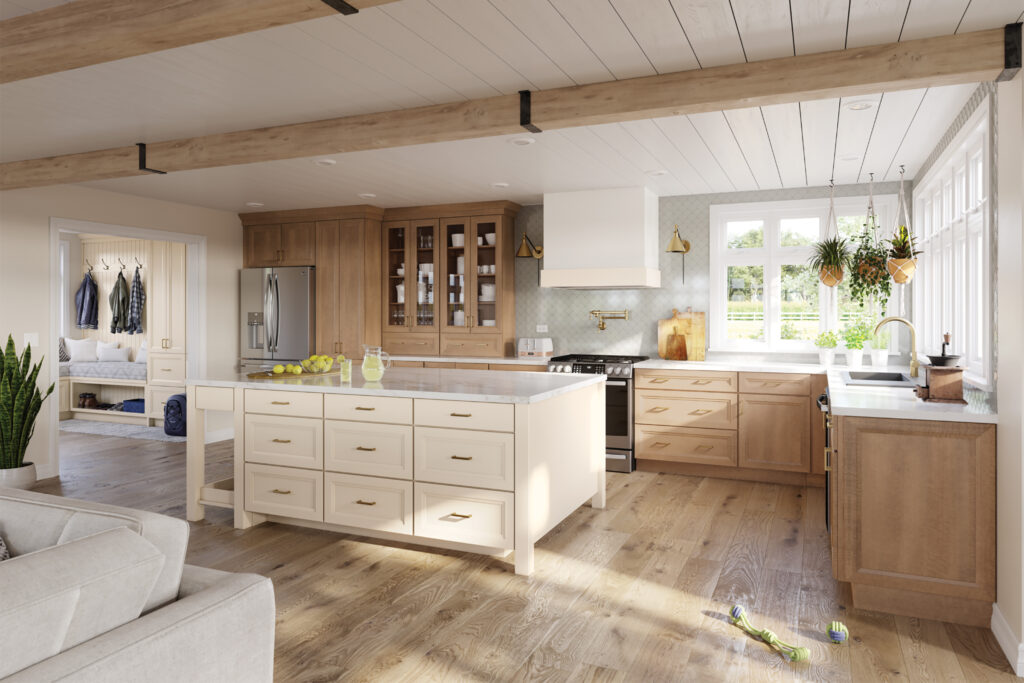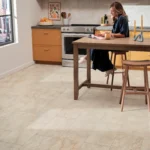When it comes to durable and stylish flooring options, both luxury vinyl tile (LVT) and ceramic tile are top contenders. Each offers unique advantages and drawbacks, making the choice between them depend on your priorities and the specific needs of your space. In this blog, we’ll compare LVT and ceramic tile across several key factors: warmth, installation, cost, and appearance.

Warmth and Comfort
LVT (Luxury Vinyl Tile): LVT is known for its warmth and comfort underfoot. Unlike ceramic tile, which can feel cold, LVT has a softer surface and can even mimic the texture of natural wood or stone. It’s an excellent choice for homes in colder climates or for areas where you’ll be standing for long periods, such as kitchens.
Ceramic Tile: Ceramic tile tends to be cooler to the touch, which can be a plus in hot climates but less appealing in colder regions. The hard surface offers little give, making it less comfortable to stand on for extended periods. However, ceramic tile can be paired with radiant heating systems for added warmth.
Winner: LVT for natural warmth and comfort, ceramic tile if paired with radiant heating.
Ease of Installation
LVT: One of LVT’s biggest advantages is its straightforward installation process. Many LVT products feature click-and-lock or peel-and-stick systems, making them ideal for DIY projects. LVT can often be installed over existing floors, further simplifying the process and reducing costs.
Ceramic Tile: Installing ceramic tile is more labor-intensive and usually requires professional expertise. It involves laying a mortar bed, cutting tiles to fit, and grouting the seams. The process is time-consuming and can add significantly to the overall cost if you hire a contractor.
Winner: LVT for its ease of installation and DIY-friendly options.
Cost
LVT: LVT is generally more affordable than ceramic tile, both in terms of material costs and installation expenses. Prices typically range from $2 to $7 per square foot, depending on the quality and design. Installation is also less expensive, especially if you opt for a DIY approach.
Ceramic Tile: Ceramic tile is more expensive, with material costs ranging from $3 to $10 per square foot. Professional installation can add $5 to $15 per square foot, making ceramic tile a higher upfront investment.
Winner: LVT for budget-friendly material and installation costs.
Appearance and Design Versatility
LVT: LVT offers an impressive array of designs that closely mimic natural materials like wood, stone, and ceramic. Thanks to advancements in printing technology, LVT can achieve realistic textures and colors. While it’s highly versatile, some purists may still prefer the authenticity of ceramic tile.
Ceramic Tile: Ceramic tile provides unmatched authenticity and a timeless aesthetic. It comes in a wide range of sizes, shapes, and finishes, allowing for intricate patterns and custom designs. Ceramic tile’s natural appeal often enhances the value of a home.
Winner: Tie. LVT excels in variety and realism at a lower cost, while ceramic tile offers authentic elegance and customization.
Durability and Maintenance
LVT: LVT is highly durable and resistant to scratches and stains, making it ideal for busy households with kids or pets. It’s also water-resistant, with some products offering full waterproofing. However, it can be prone to dents under heavy furniture.
Ceramic Tile: Ceramic tile is incredibly durable and can last decades with proper care. It’s resistant to scratches, stains, and water. However, the grout between tiles requires regular cleaning and sealing to prevent discoloration and mold growth.
Winner: Ceramic tile for longevity and overall durability, LVT for lower maintenance requirements.
Final Verdict
- Choose LVT if: You prioritize comfort, easy installation, and affordability. LVT is perfect for those seeking a budget-friendly, stylish flooring option that’s easy to maintain.
- Choose Ceramic Tile if: You value authenticity, long-term durability, and don’t mind the higher cost and professional installation. Ceramic tile is ideal for high-traffic areas or spaces where elegance is key.
Both LVT and ceramic tile offer distinct benefits, so the best choice depends on your specific needs, budget, and aesthetic preferences. Whether you’re renovating your kitchen, bathroom, or living space, either option can enhance your home with style and practicality.




